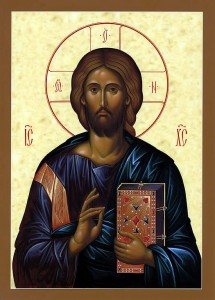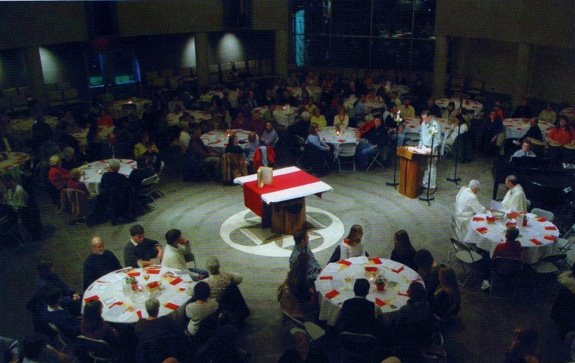
Posted on 08/05/2016 7:25:04 AM PDT by Salvation
I have a large icon of Christ in my room (see photo at right). What icons from the Eastern tradition do best is to capture “the look.” No matter where I move in the room, Christ is looking right at me. His look is intense, though not severe. In the Eastern spirituality, icons are windows into Heaven. Hence, this icon is no mere portrait that reminds one of Christ, it is an image that mediates His presence. When I look upon Him, I experience that He knows me. It is a knowing and comprehensive look.
Particularly in Mark’s Gospel, there is great emphasis on the eyes and the look of Jesus. A frequent expression in that Gospel is “And looking at them He said ….” Such a phrase (or a similar one) occurs more than 25 times in Mark’s Gospel.
Looking on Christ and allowing Him to look on you is a powerful moment of conversion. Jesus Himself said, For my Father’s will is that everyone who looks to the Son and believes in him shall have eternal life, and I will raise him up at the last day” (Jn 6:40).
And the First Letter of John says, What we shall later be has not yet been revealed. We do know that when it is revealed we shall be like him, for we shall see him as he is (1 Jn 3:2).
There is just something within us that seeks the face of God and desires that look of love that alone can heal and perfect us. I often think of this verse from Scripture when I am at Eucharistic Adoration: Look! There he stands behind our wall, gazing through the windows, peering through the lattice. (Song 2:9). Yes, I long to see the Lord. Scripture also speaks of His longing to “see” us.
Here are some passages from Scripture that remind us to seek the face of the Lord and to look to Him:
An old song says, “We shall behold Him, Face to face in all of His glory …. The angel will sound, the shout of His coming, And the sleeping shall rise, from their slumbering place. And those remaining shall be changed in a moment. And we shall behold Him, then face to face.”
Allow Christ to look on you.
This video is a wonderful collection of many of the looks of Jesus and the reaction of the people following those looks. Pay special attention. The video also features a lot of “looks” that come from us. Notice how people look upon Jesus and how they react as they do so. Look for the “looks” in this video. The final looks are especially moving.
“The function of sacred art is not to “make God come to us” like some conjuring charm, but to open our eyes, hearts, minds, to Him.”
No, that’s the function of the Holy Spirit, not the work of men’s hands.
“In this sense an icon can mediate His presence just as a Bible can, or a good sermon, or a poem, or as the hymn says, “I see the stars, I hear the rolling thunder...” the prodigious power of the Universe mediating our awareness of God’s power and presence.”
Even if those things could “mediate” God’s presence, we have no need of them, since we have perfect Mediator in Jesus Christ. Trusting in anything else is trusting in the inferior when the superior is available to you, thus it is foolishness.
“But you did not even comment on God’s omni-presence, or on any other notion I shared.”
Why bother, when those notions aren’t really relevant? I would rather focus on the central issue here than wander off down side paths that lead away from clarity.
“What do I care about Tertullian? He did not deal with the power of art and beauty to convey to our awareness, the presence of the ever-present God.”
He certainly dealt with that type of objection too, when he answered people who objected that the bronze serpent of Moses was an example of religious art that was not forbidden, in contrast to idolatry:
“But some one says, in opposition to our proposition of “similitude being interdicted,” “Why, then, did Moses in the desert make a likeness of a serpent out of bronze?” The figures, which used to be laid as a groundwork for some secret future dispensation, not with a view to the repeal of the law, but as a type of their own final cause, stand in a class by themselves. Otherwise, if we should interpret these things as the adversaries of the law do, do we, too, as the Marcionites do, ascribe inconsistency to the Almighty, whom they in this manner destroy as being mutable, while in one place He forbids, in another commands? But if any feigns ignorance of the fact that that effigy of the serpent of bronze, after the manner of one uphung, denoted the shape of the Lord’s cross, which was to free us from serpents— that is, from the devil’s angels— while, through itself, it hanged up the devil slain; or whatever other exposition of that figure has been revealed to worthier men no matter, provided we remember the apostle affirms that all things happened at that time to the People figuratively. It is enough that the same God, as by law He forbade the making of similitude, did, by the extraordinary precept in the case of the serpent, interdict similitude. If you reverence the same God, you have His law, “You shall make no similitude.” If you look back, too, to the precept enjoining the subsequently made similitude, do you, too, imitate Moses: make not any likeness in opposition to the law, unless to you, too, God have bidden it.” Tertullian, “On Idolatry”, Chapter 5
Mark 10:21 “Jesus looked at him and loved him.”
One if the functions of Our Lord the Holy Spirit, is to inspire artists.
Trrtullian was surprisingly oblivious to this point.
Nah. Keep ‘em open for the sake of the peaceful ones who simply read and ponder. You guys handle yourselves well enough. :)
Ps, thanks to Salvation and Mnsgr Pope for the morning cry with that video! ;)
“One if the functions of Our Lord the Holy Spirit, is to inspire artists.”
Where did you get that notion from? That was a function attributed to the pagan Greeks’ muses, but the Holy Spirit? I think not. The words “artist” or “artisan” don’t even appear in the New Testament at all, which is where we learn about the functions of the Holy Spirit...
I’m not Catholic, but I like the threads.



There you have it; it reduces to the simple meaning. One a child can see (and therefore respond to). It is right there in that passage.
I think it’s kinda creepy. What do you think?
I think this whole papacy is kinda creepy.
I think you misread the OP. He's not saying that the icon mediates for him, but that it mediates the presence of Christ to him.
That's a completely different thing.
But if you read "On Idolatry," all if it, it's clearly concerned with the worship of pagan deities. Your line "It matters not what they are crafting" doesn't seem to accord with the point of Tertullian's whole essay, which is that Christians need to forsake the worship of pagan gods. It's not an apologetic against the construction or use of images of Jesus, no matter how you read it.
You expect ME to find this to be inspired? I surely do not. Not inspired by Our Lord the Holy Spirit.
And this has what to do with iconoclasm? Did you mean for this Dick Vosko’s liturgical vandslism to be an *example* of iconoclasm? (That I would “get”.) Or have we jumped off into another topic entirely?
Very nice analogies and they are very sweet.
But the Bible in Exodus 20:4 is very explicit. And Paul’s sermon on Mars Hill expounds upon that.
Our feelings should have nothing to do with it.
And those were the Jews who had bought into some of the Grecian philosophy. Prior to that the Jewish believers would have none of it.
And we can see how well mixing Greek and Jewish philosophy has helped Christianity.
My dear Boogieman, if the Bible’s enough for you, why on earth are you quoting Tertullian?
And what are you doing on Free Republic?? Wonderful we may be, but ain’t none of us composing Sacred Scripture!
BTW, the two greatest anti-idolatry voices in the early Church, Tertullian and Gregory the Great, both noted that the carved images of the Cherubim in the Holy of Holys, and the bronze serpent lifted up by Moses, were NOT against God’s law because they were NOT meant for idolatrous purposes.
So there’s your criterion: if it’s not meant for idolatrous purposes, it’s not idolatry.
And normal people understand this. Rare is the crank who would object to Christmas Nativity figurines, or carven angels found next to the “Praying Hands” on tombstones in Christian cemeteries.
It got to me too.
I never liked it and decided not to use it.
Disclaimer: Opinions posted on Free Republic are those of the individual posters and do not necessarily represent the opinion of Free Republic or its management. All materials posted herein are protected by copyright law and the exemption for fair use of copyrighted works.